The topic of ‘Russia tariff treatment’ has been a focal point in recent international trade discussions, particularly in light of ongoing geopolitical tensions and economic negotiations. Here are the key developments and implications surrounding this issue:
- White House Ties Russia Tariff Absence to Ongoing Negotiations:
- The White House linked the absence of tariffs on Russia to ongoing negotiations aimed at resolving the conflict. The US President decided not to mix the tariff issue with these negotiations, emphasizing that maintaining peace is prioritized, making tariffs counterproductive during this period.
- US Tariffs to Hinder Sustainable Development, Warns UN:
- UN spokesperson Stéphane Dujarric warned that US tariffs would negatively impact sustainable development goals. The US imposed tariffs on imports with a base rate of 10%, with higher rates for most countries based on US trade deficits. The EU imports face a 20% tariff, while the US President views these tariffs as a declaration of economic independence.
- US Tariffs Boost Russia-India Economic Ties:
- Increased US tariffs on countries like India (26%) may benefit Russia-India economic cooperation. Restricted US market access for India could increase Indian interest in supplying goods to Russia, presenting an opportunity for Russia to expand trade and access new market niches in India.
- EU Rejects Russian LNG Ban Amid US Tariff Concerns:
- The EU rejected a ban on Russian liquefied natural gas (LNG) imports due to US President Trump’s tariffs. The European Commission plans a new roadmap to end the bloc’s reliance on Russian energy by 2027. The EU sees US tariffs as a bargaining chip to negotiate lower tariffs with the US administration.
- Russia’s SWIFT Return: A Path to Renewed US-Russia Trade?:
- Russia’s return to the SWIFT international banking system could be the first step in restoring trade relations between Russia and the USA. The US Treasury Secretary indicated that the US is willing to consider Russia’s return to SWIFT in the context of resolving the Ukrainian crisis.
In summary, the current tariff treatment of Russia is intricately linked to broader geopolitical negotiations and economic strategies. The absence of US tariffs on Russia is seen as a strategic move to facilitate peace negotiations, while increased tariffs on other countries like India may inadvertently strengthen Russia’s economic ties with these nations. The EU’s stance on Russian LNG imports and the potential return of Russia to the SWIFT system are also critical factors that could shape the future of US-Russia trade relations. These developments highlight the complex interplay between economic policies and international diplomacy in addressing the ongoing conflict and its global implications.

